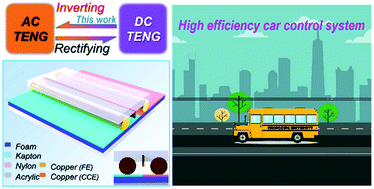An inverting TENG to realize the AC mode based on the coupling of triboelectrification and air-breakdown†
Abstract
As an efficient power technology, a triboelectric nanogenerator (TENG) has made a huge impact on many research fields and exhibits exciting prospects in the future world. There are two output modes of the TENG, the alternating current (AC) mode based on the coupling of triboelectrification and electrostatic induction, and the direct current (DC) mode based on the coupling of triboelectrification and air-breakdown. AC can be converted into DC by rectification. However, from the symmetry argument, there should be an inverting mode to convert the DC into AC. Herein, an inverting TENG to realize the AC mode based on the coupling of triboelectrification and air-breakdown is proposed for the first time by setting alternating polarity distribution areas. Different from the fixed waveforms of a traditional AC-TENG, the inverting TENG exhibits such unique characteristics that both the width ratio and amplitude ratio of AC signals can be changed by tuning the distributed width and electronegativity difference of two opposite materials. This work paves the way for the development of a symmetry output mechanism for the TENG, from AC to DC, and from DC to AC, or even hybrid DC and AC in one TENG, and these powerful functions endow the inverting TENG with more advantages for future self-powered intelligent systems.



 Please wait while we load your content...
Please wait while we load your content...